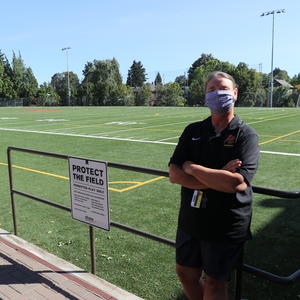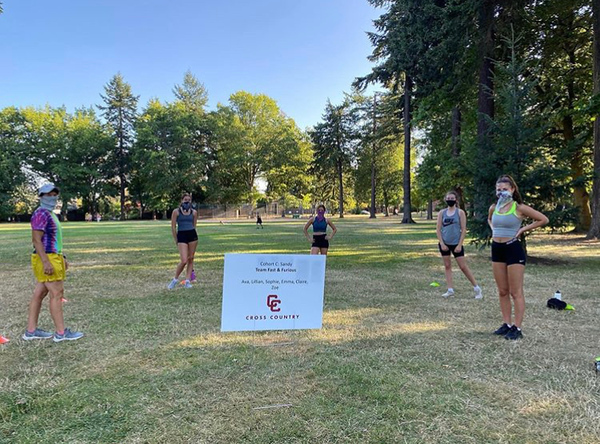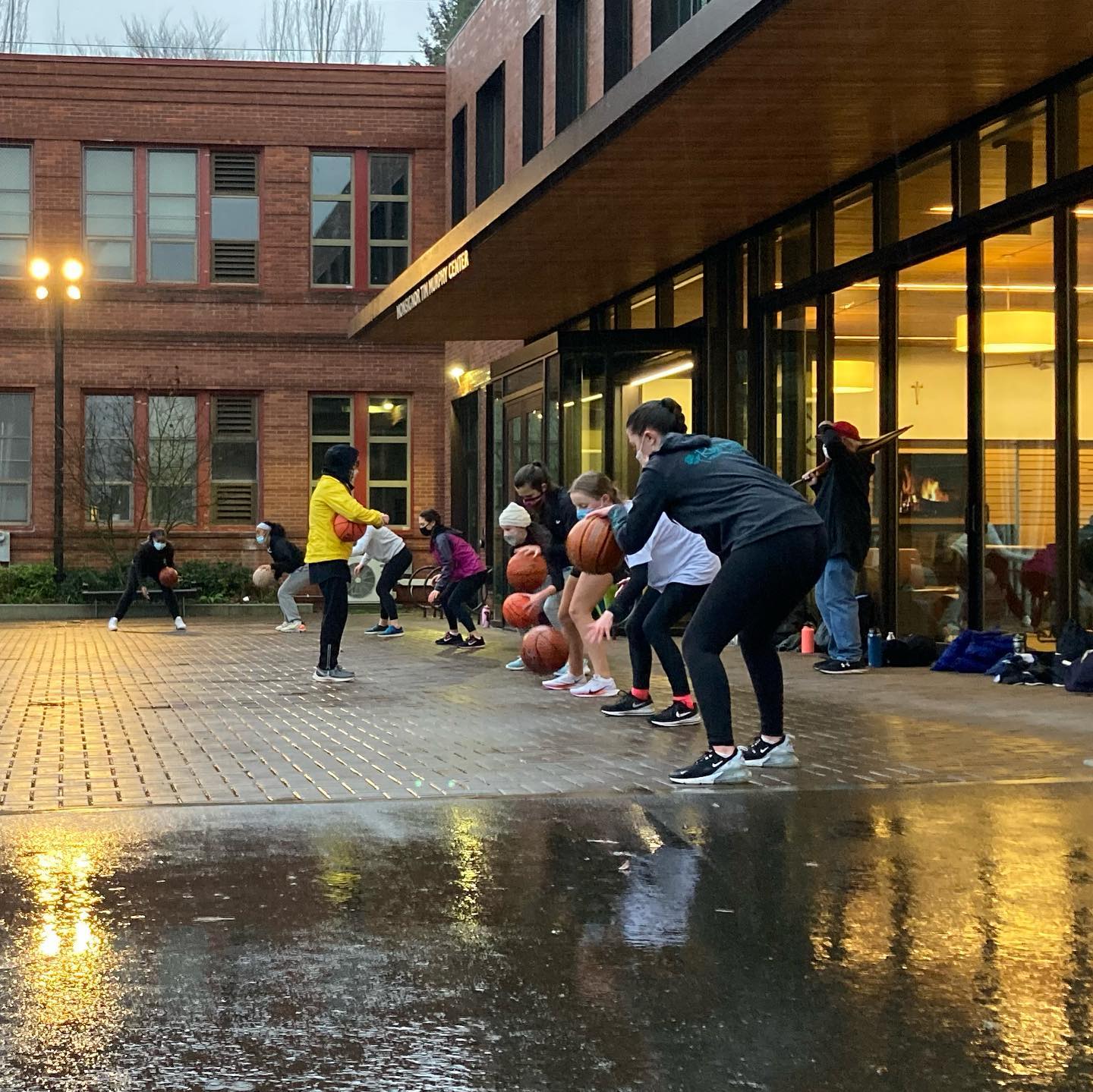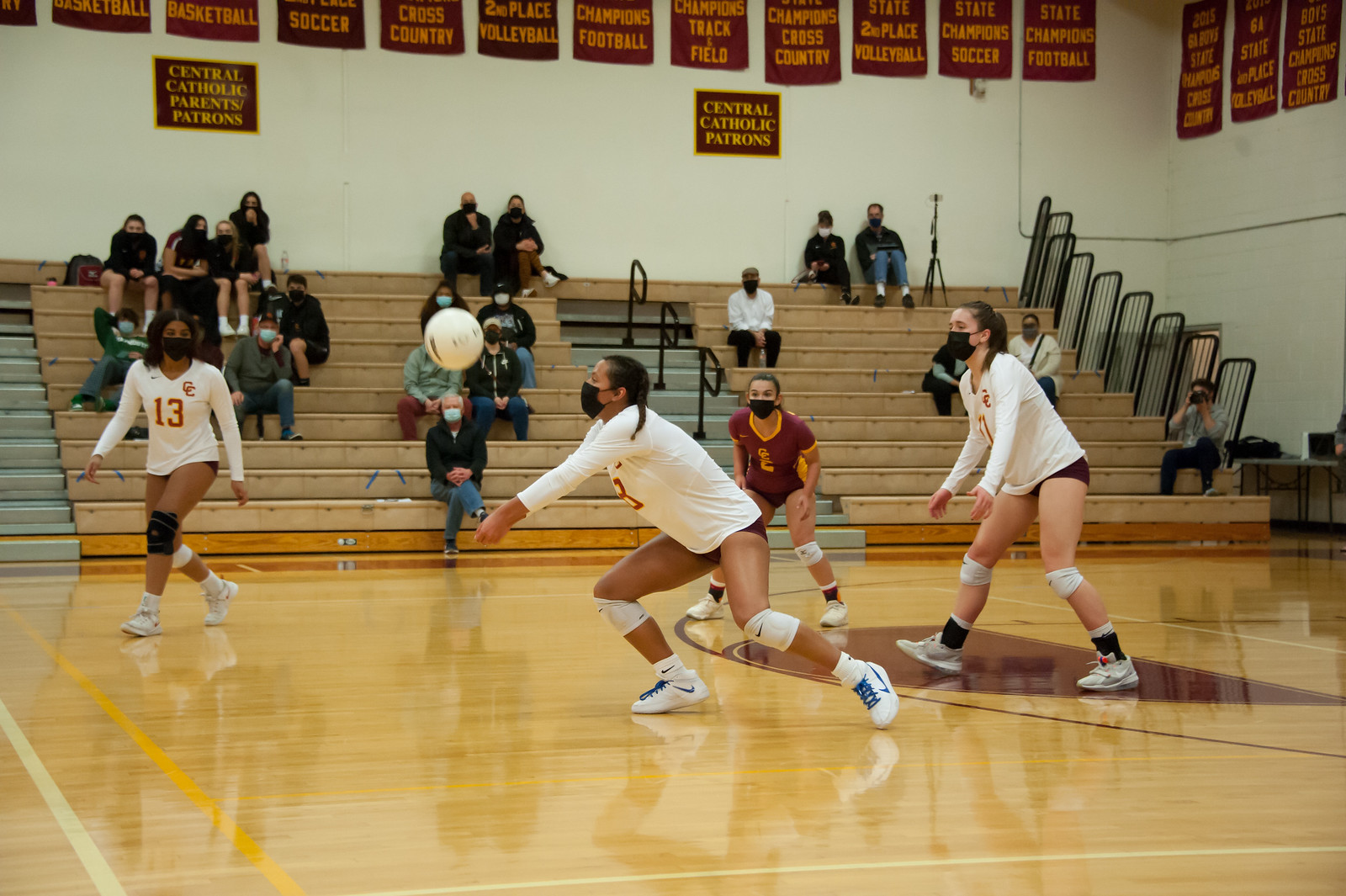News
Faculty Profile - Laura Jaeger

In a normal school year, the job of Athletic Director is one of the busiest, most demanding positions at Central Catholic. It requires nonstop management of logistics and communication all year round. But in the face of COVID-19, a “normal year” and the subsequent responsibilities of Athletic Director were thrown out the window. Instead, they were replaced by constantly evolving, changing, and unclear situations that would span for months and eventually become what was this year’s athletic season. Heading the charge of overseeing this unconventional year of athletics was Central Catholic’s Athletic Director, Laura Jaeger. Laura played an integral role in making this year of Central Catholic Athletics not only possible, but also successful. With the support of the Athletics Department team, coaches, players, and families, Ram Athletics saw an unforgettable and successful year.
Back in early March of 2020, Central Catholic sports were in full swing. The boys’ basketball team was getting ready to compete in the state championship, the swim team had just finished competing in the state tournament, and all the while, Laura and her team were preparing for the start of spring sports. The Central Catholic Athletics Department, which consists of only three people—Laura Jaeger, Patti Johnson, and Andrew Green ‘13—was at one of its busie st times of the year. While having to manage the end of winter sports, including overseeing set-up, equipment, and supervision for all games, they were simultaneously securing facilities, scheduling practices and games, and managing transportation for all spring sports. It was a busy, but exciting time for Central Catholic Athletics, but that would all come to a screeching halt.
st times of the year. While having to manage the end of winter sports, including overseeing set-up, equipment, and supervision for all games, they were simultaneously securing facilities, scheduling practices and games, and managing transportation for all spring sports. It was a busy, but exciting time for Central Catholic Athletics, but that would all come to a screeching halt.
As the COVID-19 pandemic quickly evolved, it became evident that sports would soon have to pause. On March 12, 2020, Central Catholic was preparing to move to all-digital learning for four weeks and Laura had to communicate with all of the coaches and athletes about this pause. She remembers that time vividly, saying, “I had to pull the girls’ lacrosse team in and get the word out to all of our coaches that our season would be postponed for a while.” One by one, Laura spread the news to all athletes, coaches, and families about the pause. It was a disappointing time for so many Central Catholic athletes, especially for the seniors, as their last high school athletic season would be cut short.
Laura quickly rallied the teams and coaches together to strategize how they could keep students engaged and active. One quick and simple way they accomplished this was through social media. Patti and Andrew helped each team set up Instagram and Facebook accounts and made sure they were engaging with their athletes. They also taught coaches and athletes how to use Zoom, which would remain a staple for facilitating and planning workouts and holding team meetings. The coaches went above and beyond to keep their athletes active, engaged, and united during a time of extreme stress and uncertainty.
Throughout the spring, COVID-19 cases and resulting restrictions continued to ramp up. It was early May when the news finally came: there would be no spring sports season. “This was a big disappointment for our spring athletes to not have any season at all,” Laura shares. But despite this let-down, the coaches continued to engage their athletes through virtual workouts, team meetings, and social media.
Entering into the summer, the hope was to begin holding in-person workouts. However, with restrictions still in place and limited in-person gatherings, group workouts were not yet allowed. Laura was constantly in communication with Oregon School Activities Association (OSAA) throughout that time, and relied on their guidance for giving the green light to hold practices and workouts. But, like many agencies, there was still so much uncertainty and many unknowns. “The uncertainty, and OSAA not knowing when things could start up again, was a big struggle during that time,” Laura shares. “I always felt like I had some not-so-great news to deliver to teams.”
The amount of communication and varying decisions coming from OSAA was indicative of the uncertainty at the time. Laura was receiving new information from OSAA nearly every week at the beginning of the pandemic, each packed with different decisions or new guidance. Working in conjunction with the Governor’s Office, Oregon Health Authority, and Oregon Department of Education, OSAA created guidelines for restarting practices and games based upon metrics and safety measures. Laura had to keep up with this nonstop flow of information and updates, and constantly communicate this news to the coaches and athletes. Summer continued on with no concrete decision. Finally in August there arrived some direction for high school athletics for the 2020-2021 school year. Due to uncertainty around school reopenings, OSAA made the decision to move fall sports to  the spring. Later in the year, they would also shift winter sports to after spring season, as COVID cases continued to increase throughout the fall.
the spring. Later in the year, they would also shift winter sports to after spring season, as COVID cases continued to increase throughout the fall.
Also in August came some good news. Cross Country received the go-ahead to hold practices at parks, so coaches quickly organized workouts for the athletes. Then, beginning in early September, basketball, football, and volleyball teams were finally able to hold workouts and modified practices. Because practices could only be conducted outside, however, coaches of indoor sports had to be more creative with their workouts. Basketball coaches ran ball-handling drills in the courtyard, volleyball did strength and conditioning on Harrington Field, and almost all the teams got together every week to do something, rain or shine.
One factor that made these practices possible was the newly installed lights on Harrington Field. These lights allowed more teams to practice on the field, as the teams were not limited only to daylight hours, and they could practice in safety. “If we didn’t have the lights,” Laura shares, “we would not have been able to use the field like we did. We would have had teams practice on other fields, and we felt much safer having them here, not in public parks where there was more increased risk for COVID exposure.”
With the season and schedules set in place, Ram Athletics continued to hold in-person workouts and team meetings during the fall. That period was not without its uncertainty and challenges, however. Laura faced the ups and downs of frequent information updates and had to stay on top of the constantly changing metrics, safety procedures, and paperwork that was required. Before each practice, “We had to take temperatures, do an incredible amount of paperwork, and complete monitoring forms,” Laura explains. “Every day when teams met, coaches had to get monitoring forms from their athletes. That’s because, if someone were to get COVID, we’d have contact tracing and know which pod would need to be shut down.” Laura collected and managed these large swaths of documents and stayed on top of teams to ensure they were all doing the necessary tracking.
March of 2021 arrived, and Ram Athletics would finally see its teams compete for the first time in nearly a year. Because of the altered sports schedule, seasons that were supposed to be eleven weeks long got crunched down to only seven weeks. The first sports season was fall sports, followed by spring, and then winter.
Competitions proved to have an entirely different set of challenges, including transportation to and from games and spectator attendance. Transportation was minimal, as there was a capacity limit for each vehicle, so Central Catholic asked parents to provide transportation for their students. “But if there was a hardship, such as a parent’s work, we asked them to let us know and we would provide transportation,” Laura shares.
Then the issue of spectators came into play. At the beginning of the fall sports season, no spectators were allowed at all. After metrics began improving, OSAA finally allowed limited spectators to attend competitions. One  requirement, however, was that schools ensure there was proper contact tracing for each spectator in attendance. Laura and her team came up with an easy solution using a voucher system. “We allowed each athlete to give two vouchers to their family members to attend,” Laura explains. “They had to fill out their name, phone number, and answer screening questions if they were experiencing any COVID symptoms.” They used this system of printing and providing vouchers for athletes to hand out for every game. Eventually they were able to expand the number of spectators as capacity limits increased for stadiums and gyms, but each person was still required to fill out a voucher.
requirement, however, was that schools ensure there was proper contact tracing for each spectator in attendance. Laura and her team came up with an easy solution using a voucher system. “We allowed each athlete to give two vouchers to their family members to attend,” Laura explains. “They had to fill out their name, phone number, and answer screening questions if they were experiencing any COVID symptoms.” They used this system of printing and providing vouchers for athletes to hand out for every game. Eventually they were able to expand the number of spectators as capacity limits increased for stadiums and gyms, but each person was still required to fill out a voucher.
Another challenge throughout these modified seasons was the sheer amount of hands-on work that was needed. With a staff of just three people, the Athletics Department had to be everywhere, spending long hours supervising games and practices, and handling logistics. In one day, Laura would be out at Delta Park marking bleachers and the dugout with X’s six feet apart, back to school to make sure teams had their equipment, and then back out to the field to screen the referees for COVID symptoms. For one week, fall and spring sports overlapped and were going on at the same time. “That week was probably the hardest week of my career at Central Catholic,” Laura shares. “We had all fall sports still practicing, and all spring sports needing field time. We did end up sending a few teams to city parks to practice, but it worked out.” The extra hands-on work and modified season stretched Laura and her team thin, but they were able to make it all happen safely.
Another result of the reduced seasons was that there were no state tournaments, which was, to some, a refreshing change. The focus remained on giving students the opportunity to play, rather than aiming for an end goal of winning a big title or trophy. But this didn’t inhibit the competitiveness of our athletes and teams. They still performed exceptionally well, with teams finishing in the top rankings within the 6A Mt. Hood Conference league.
Despite the amount of uncertainty and constant change that persisted throughout this last year, there have been incredible successes and highlights as well. When reflecting back on this year, what stands out to Laura is the amount of work the Athletics Department and coaches put into engaging with the athletes. “We were one of the first and most consistent schools to have workouts and provide opportunities for students on campus,” Laura shares. “Our goal was to give these athletes an opportunity to be with their coaches and teams.” Laura, her team, and all the coaches went over and above what was expected of them in order to make that happen. And it brought her joy to see the students have this opportunity. “My favorite day was when we had our first on-campus practice and I saw athletes checking in, and seeing each other for the first time in a while. Their joy is my joy when I see that aspect of it.”
Without a doubt, this year required a lot of resilience on everyone’s part, but especially for Laura and the Athletics Department. “You have to be pretty resilient to do this, because things are constantly changing. I would put a document out and within three days it was obsolete,” Laura explains. “To pick yourself up and send it out again or communicate it again to all of your coaches,” she pauses before continuing, “We’ve had to be extremely flexible.” It also took working as a team to get through thick and thin—working long hours or just being able to shift on a dime because something changed. “My team is really a huge part of why this past year was a success.”
This year has made Laura realize just how important high school athletics are. “I don’t think I’ll ever think about high school athletics in the same way,” she shares. “I’ve always believed athletics has played an important role in students’ motivation—in their development—and I think during COVID people have really seen that, with the lack of opportunities for some students.” This year has emphasized for her just how crucial a role athletics plays in students’ development.
Thanks to the hard work, long hours, and determination on the part of Laura and her team, Patti and Andrew, they were able to provide these critical opportunities to our Central Catholic students. They enabled Ram Athletics to become an integral part of our students’ experience at Central Catholic. Perhaps most importantly, they enabled these students to be resilient and gain the skills to succeed in athletics, academics, and life.